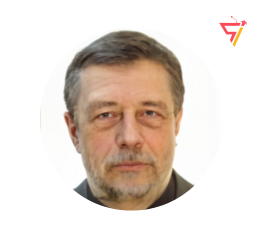Scholars International Conference on
Physics and Quantum Physics
THEME: "Highlighting innovations and challenges in the field of Physics and Quantum Physics"
 25-26 Mar 2024
25-26 Mar 2024  Barcelona, Spain
Barcelona, Spain THEME: "Highlighting innovations and challenges in the field of Physics and Quantum Physics"
 25-26 Mar 2024
25-26 Mar 2024  Barcelona, Spain
Barcelona, Spain 
FSRC “Crystallography and Photonics”, RAS, Moscow, Russia
Title: Quantum-Classical Mechanics: Principles, Applications, and Prospects
Prof Dr Vladimir Valentinovich Egorov has his expertise in theoretical molecular and chemical physics. Education: National Research Nuclear University MEPhI, Faculty of Theoretical and Experimental Physics (1966 – 1972), Moscow, USSR. He has completed his PhD from Theoretical Department of Institute of Chemical Physics, USSR Academy of Sciences (1981), and he has completed his Dr Phys&Math Sci degree from Institute of Physical Chemistry, Russian Academy of Sciences (2004). He is leading researcher at FSRC “Crystallography and Photonics”, Russian Academy of Sciences, Moscow, Russia. Prof Egorov is working on the development of a fundamentally new physical theory ? quantum-classical mechanics and its applications in physics, chemistry, biology and biomedicine.
In quantum mechanics, the theory of quantum transitions is
grounded on the convergence of a series of time-dependent perturbation theory.
In nuclear and atomic physics, this series converges because the dynamics of
quantum transitions are absent by definition. In molecular and chemical
physics, the dynamics of “quantum” transitions, being determined by the joint
motion of a light electron (or electrons) and very heavy nuclei, are present by
definition, and this series becomes singular. An exception is the dynamic
problem for stationary states in the Born-Oppenheimer adiabatic approximation,
when the electronic subsystem turns out to be “off” from the general dynamic
process and therefore is not dynamically full-fledged: it only forms an
electric potential in which the nuclei oscillate. Removing the aforementioned
singularity can be accomplished in two ways. The first method was consisted of
introducing an additional postulate in the form of the Franck-Condon principle
into molecular quantum mechanics, in which the adiabatic approximation is used.
The second method was proposed by the author and consisted of damping the
singular dynamics of the joint motion of an electron and nuclei in the
transient state of molecular “quantum” transitions by introducing chaos. This
chaos arises only during molecular quantum transitions and is called dozy
chaos. Dozy chaos leads to the continuity of the energy spectrum in the
molecular transient state, which is a sign of classical mechanics. Meanwhile,
the initial and final states of the molecule obey quantum mechanics in the
adiabatic approximation. Molecular quantum mechanics, which takes into account
the chaotic dynamics of the transient state of molecular “quantum” transitions,
can be called quantum-classical mechanics (QCM). The efficacy of the damping
for the aforementioned singularity is shown by different QCM applications, in
particular, by applications of the so-called Egorov resonance to optical
spectra in polymethine dyes and J-aggregates both for single-photon and
two-photon processes, which, in particular, are rationalizing experimental
studies in the field of bioimaging and photodynamic therapy. Prospects for
further developments in QCM and their applications to problems of cancer and
viral infections are discussed. Applied development of the theory will also be
associated with the complication of a quantum-classical system by organizing
various molecular aggregates in order to find the “molecule of life”, that is,
that rather complex, but “minimal” structural configuration, in which there are
clear elements of self-organization, both structural and dynamic. Note that the
“atom of life” is the quantum-classical electron itself, which provokes dozy
chaos. Of particular interest are experimental studies on the search and
synthesis of the “molecule of life”.
Funding: This work was supported by the Ministry of Science and
Higher Education within the State assignment Federal Scientific Research Center
“Crystallography and Photonics”